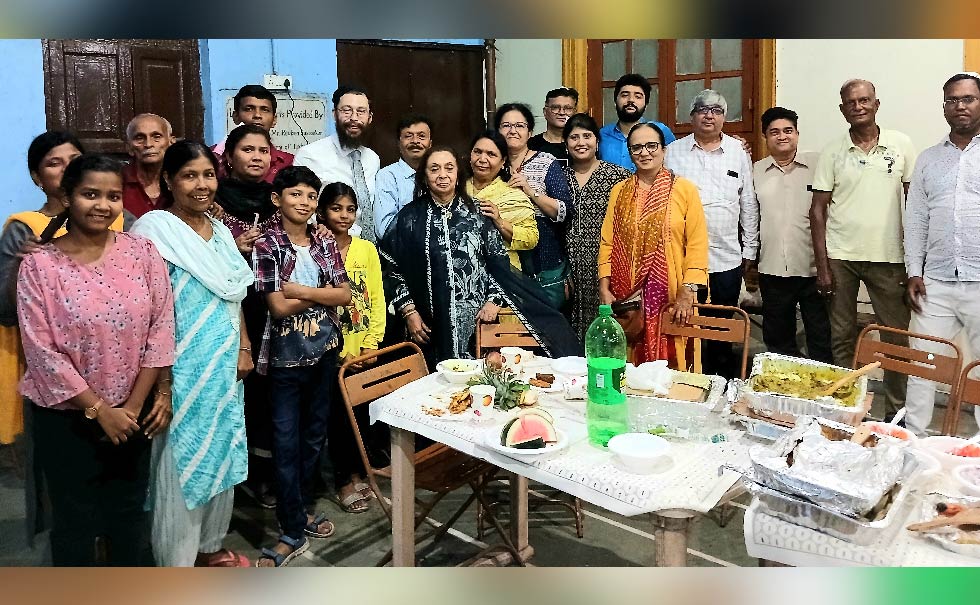Parshat Beshalach
Inspiration is much like a sea; waves of climbing and falling, times of stillness, and times of crashing chaos:
In our Parsha, perhaps one of the most famous moments of imagery and resolutions of tension in the Tanach, the sea of reeds is split, and the children of Israel pass from Egyptian slavery to Divine service for all eternity.
As I write these words, I am about a mile from the Bristol channel, the long stretches of the beautiful shingle beach that overlook Wales from Western Somerset.
The symbolism of the sea in terms of inspiration is perceived viscerally here, we walk along the beaches and marches – these short walks are a wonderful break from the lockdown and isolation of being at home with small children for the majority of the day, we find our own freedom currently with a view of the sea before us.
Water is used as a metaphor for Torah in a variety of places:
In Egypt, according to Jewish Tradition, the rivers provided a source of unlimited water at all times, with the knowledge of the flooding of the Nile.
But Israel is different: Rain comes from heaven under Divine command, this is reflected for example, in Devarim/Deuteronomy 11:10-17, (the source for the second paragraph of the Shema).
The usage of “water” is used within the Talmud as a metaphor for Torah, these ideas are drawn from a variety of sources such as:
Isaiah 55:1:
ה֤וֹי כָּל־צָמֵא֙ לְכ֣וּ לַמַּ֔יִם וַאֲשֶׁ֥ר אֵֽין־ל֖וֹ כָּ֑סֶף לְכ֤וּ שִׁבְרוּ֙ וֶֽאֱכֹ֔לוּ וּלְכ֣וּ שִׁבְר֗וּ בְּלוֹא־כֶ֛סֶף וּבְל֥וֹא מְחִ֖יר יַ֥יִן וְחָלָֽב׃
“Ho, all who are thirsty, come ye for water, even if you have no money; Come! buy food and eat. Buy food without money; wine and milk without (any) cost.”
The Rambam (Maimonides) redacts the Talmud teaching on this verse and expounds on the idea as follows:
Mishneh Torah, Laws of Torah Study 3:9
The words of the Torah are likened unto water, even as it is said:
“Ho! Everyone that thirsteth, come ye for water” (Isaiah 55.1), which is to teach you, even as waters do not gather in steep places, but flow by gravity and gather in a well, so are the words of the Torah, they are not found among the high spirited nor in the heart of all haughty but in the humble and meek spirited who embraces the dust of the feet of the wise and removes the passions and the pleasures of the age from his heart and does a little work daily for his living if he happens to be unprovided with food, and the rest of his days and his nights he pursues the study of the Torah.
(Sources: Talmud Ta’anit, 7a & Erubin, 55a- translation courtesy of Sefaria.com)
Also interestingly enough In the Bamidbar Rabbah (1:7), the idea is further extrapolated:
“And God spoke to Moses in the Sinai Wilderness” (Numbers 1:1). Why the Sinai Wilderness? From here the sages taught that the Torah was given through three things: fire, water, and wilderness. How do we know it was given through fire? From Exodus 19:18: “And Mount Sinai was all in smoke as God had come down upon it in the fire.” How do we know it was given through water? As it says in Judges 5:4, “The heavens dripped, and the clouds dripped water [at Sinai].” How do we know it was given through wilderness? [As it says above,] “And God spoke to Moses in the Sinai Wilderness.” And why was the Torah given through these three things? Just as [fire, water, and wilderness] are free to all the inhabitants of the world, so too are the words of Torah free to them, as it says in Isaiah 55:1, “Oh, all who are thirsty, come for water… even if you have no money.”
(translation courtesy of Sefaria.com)
If water is metaphorically used to connote Torah, the sea represents the source of such wisdom – it is interesting that the Gematria of “Sea” יַּם has a numerical equivalent of 50, corresponding to the “50 levels of Chochma (wisdom)” as the Talmud teaches; “Fifty Gates of Understanding (were) created in the world, and they were all given, except for one” (Rosh HaShanah 21b & Nedarim 38a ) – it is interesting to note that the Vilna Gaon (in Aderes Eliyahu, Parshat Balak) teaches that there are 50 occasions Exodus is mentioned in the Torah correspond to the 50 Gates of Understanding”.
Spiritual life is often like water, if left stagnant it becomes murky – it is every day that someone contacts me about feelings of frustration with their daily practice, with their communities, and relationships. Feelings ebb and flow like waves, moments of powerful inspiration followed by crashes and sometimes long periods of calm or placid languid restlessness.
in our Parsha, the children of Israel experience a phenomenal and miraculous moment, immediately they transition from prophetic rapture to total disappointment and disillusion.
21 And Miriam called out to them, Sing to the Lord, for very exalted is He; a horse and its rider He cast into the sea
כא וַתַּ֥עַן לָהֶ֖ם מִרְיָ֑ם שִׁ֤ירוּ לַֽיהֹוָה֙ כִּֽי־גָאֹ֣ה גָּאָ֔ה ס֥וּס וְרֹֽכְב֖וֹ רָמָ֥ה בַיָּֽם:
22 Moses led Israel away from the Red Sea, and they went out into the desert of Shur; they walked for three days in the desert but did not find water
כב וַיַּסַּ֨ע משֶׁ֤ה אֶת־יִשְׂרָאֵל֙ מִיַּם־ס֔וּף וַיֵּֽצְא֖וּ אֶל־מִדְבַּר־שׁ֑וּר וַיֵּֽלְכ֧וּ שְׁלֽשֶׁת־יָמִ֛ים בַּמִּדְבָּ֖ר וְלֹא־מָ֥צְאוּ מָֽיִם
23 They came to Marah, but they could not drink water from Marah because it was bitter; therefore, it was named Marah.
כג וַיָּבֹ֣אוּ מָרָ֔תָה וְלֹ֣א יָֽכְל֗וּ לִשְׁתֹּ֥ת מַ֨יִם֙ מִמָּרָ֔ה כִּ֥י מָרִ֖ים הֵ֑ם עַל־כֵּ֥ן קָֽרָא־שְׁמָ֖הּ מָרָֽה:
24 The people complained against Moses, saying, What shall we drink?
כד וַיִּלֹּ֧נוּ הָעָ֛ם עַל־משֶׁ֥ה לֵּאמֹ֖ר מַה־נִּשְׁתֶּֽה:
(fourth Aliyah/Shemot chapter 15 – courtesy of Chabad.com)
Barely a few Pasukim from this earth-shattering experience and already the complaining begins!
We must factor into our thoughts surrounding this the children of Israel themselves moved from slavery and destitution to self-reliance and religious freedom, whereas the power of Hashem as a mighty force capable of redemption was accepted – the individual providence of Hashem providing the basic requirements of each member of the people was, perhaps not fully realized.
25: So he (Moses) cried out to the Lord, and the Lord instructed him concerning a piece of wood, which he cast into the water, and the water became sweet. There He gave them a statute and an ordinance, and there He tested them. כה וַיִּצְעַ֣ק אֶל־יְהֹוָ֗ה וַיּוֹרֵ֤הוּ יְהֹוָה֙ עֵ֔ץ וַיַּשְׁלֵךְ֙ אֶל־הַמַּ֔יִם וַיִּמְתְּק֖וּ הַמָּ֑יִם שָׁ֣ם שָׂ֥ם ל֛וֹ חֹ֥ק וּמִשְׁפָּ֖ט וְשָׁ֥ם נִסָּֽהוּ:
(Ibid)
The immediate response from Hashem through His Torah is this “wood” that is understood by the deeper sources (such as Zohar 3:153a:13 & the Zohar Chadash, Beshalach: 9) to be a metaphor for the Torah the “Tree of Life” itself, both in terms of the Written and Oral Torah:
The solution for the bitter waters of life, these moments of lack of inspiration in our daily lives is to instead focus on learning inspiring things! Seems an obvious thing to say, and indeed it verges on simplism – since most scholars will attest to you that the Torah subjects that are perhaps most inspirational and interesting also tend to be quite difficult sources. Many Baalei Tshuvah or those interested in understanding the depth of traditional source-based Judaism often become frustrated by the language barrier of their Hebrew or Aramaic, many sources throughout Talmud, Midrash, Kabbalah, and Chassidut assume a breadth of knowledge in terms of Tanach and Midrash that so many of us on this path were not blessed to be exposed to.
Unfortunately, a great deal of Kiruv focuses almost exclusively on Talmud learning (to a certain extent, with the correct approach and guidance it is possible to study and fill in many gaps as the student progresses), another branch exists with a focus on the mystical Torah, often metaphorical Kabbalistic ideas are projected onto modern events, some even, unfortunately with extremist messianic theologies, the basis for this application of Kabbalah in this manner seems totally at odds with the introductions to the subject by authors such as the Ben Ish Chai (D’aat T’nuvah), the Ramak (Pardes Rimonim), and the introduction to the Zohar by the Matok U’Dvash, who all state unequivocally that the entire subject of Kabbalah is entirely symbolic and metaphorical and that the application of some of the ideas taken literally could highly problematic theologically.
Torah as diet requires healthy balance and variety, as we see the metaphorical device of water applied to Torah so too, with bread, wine, and meat – it represents a complete meal, or Sudah (in terms of symbolism).
The best approach by far, is for daily study consisting of PARDES, as my own Rav, Rabbi Chaim Mizrachi Rosh Yeshivah of the Leshem Yeshiva taught me, that every day must have some written Torah study; both from the Parsha and the Prophets & Writings, Mishnah, Halacha (Rambam and modern Poskim) and something akin to Midrash/Kabbalah – we must imagine that a meal consisting of a single dish – no matter how delicious would be considered incomplete when one considers the possible variety of Torah subjects and areas of study.
This is really the only way to play “catch up” and to cover ground, as we enter the search for the theology of Judaism we must strengthen our Spiritual and Rabbinical knowledge to see the system in its completion – the feeling of completion that comes with the chapters and subjects that we read is a great mechanism of generating self-inspiration.
If one considers the Daf-Yomi program where students study a single, double-sided page of Talmud daily and finish the entire Talmud Bavli in 7 years – it is truly inspiring. The total number of chapters in the 24 books is 929 (the total number of verses is 23,099), if one were to read 3 chapters a day one could complete the Tanach in a year. In terms of Mishnah: there are 525 Perkim with a total of 4224 individual Mishnayot, making it possible to complete it each year if one learns two chapters a day.
When one considers what an individual could achieve, it is truly inspiring – the only barrier to such achievements is our own self-doubt or inability to master the self-control required to achieve the unthinkable.
Rather than see the task as daunting to gain knowledge and breadth in learning, let us be inspired to build a regular daily schedule and to keep to it, to seek out the Tree of Life that sweetens the waters of daily life with spiritual content and ideas that force us to consider things differently, truly this is our heritage as the Children of Israel – it is profound that our Parsha and this message falls this week during International Holocaust Memorial Day, we can see from recent as well as ancient Jewish history that we have managed to maintain our connection to our traditions and our faith during unthinkably hard times.
The responsibility of the Torah requires that we take our learning and inspiration into our own hands and accept that in terms of our spiritual life we hold the reins and motivation to our own level of connection as the Mishnah says eloquently (Pirkei Avot 5:23) “According to the labor is the reward”.
May Hashem bless us to be sources of inspiration to ourselves, and each other,
Shabbat Shalom
Rabbi Jonathan Goldschmidt 2021 ©




